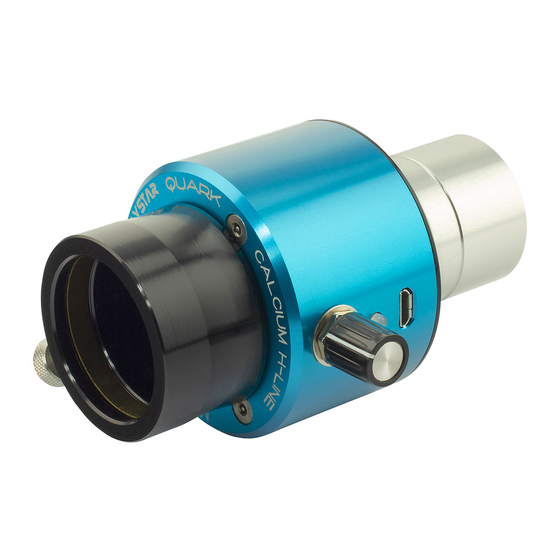- ページ 8
アクセサリー DayStar Filters CALCIUM QUARKのPDF マニュアルをオンラインで閲覧またはダウンロードできます。DayStar Filters CALCIUM QUARK 17 ページ。

About Seeing Limitations and Resolution:
Solar observing seeing conditions vary greatly from nighttime conditions.
During the daytime, radiant heating from the sun affects seeing
significantly. Characterized by turbulence or shimmering as seen over a
hot street, seeing can cause significant impact on quality of solar
observations.
- Bad seeing is caused by air of different temperatures mixing. This
typically happens within the lowest 10 feet of air. It occurs most often
over
pavement,
dark
objects,
rooftops
and
sometimes
trees.
- High cirrus clouds or "scuzz" will cause scattering of sunlight in the high
atmosphere which often makes for bad viewing conditions. A classic
sign of high cirrus clouds is the inability to achieve focus, or the need to
"chase focus", or a lack of contrast. Calcium is particularly susceptible to
poor transparency.
- A jet-stream moving overhead can also hurt seeing conditions even on
a clear day.
DayStar Filters are high power viewing platforms and this high resolution
can be susceptible to seeing issues. Solar Observers using high
powered, high resolution telescopes and DayStar filters should heed
daytime seeing. While many of these conditions are beyond our control,
observing in an area with ideal conditions, without pavement in the
direction of viewing, and on days with no high cirrus will offer best
results. Grass is the best environment for daytime seeing stability.
Each observing location offers different behavior for daytime seeing cells
at different times of the day, as the air through which one views changes
with movement of the sun. Some locations benefit from best seeing in
the morning, while many have best seeing in the afternoon. Because
most heat variation between air and ground surfaces occurs within the
first 10 feet above the ground, often a high observing platform will offer
superior seeing. This might include a second story deck which overlooks
grass.
Solar Imaging Tips:
Daystar recommends MONOCHROME CCD imaging whenever
possible for best results. The recent availability of CCD cameras and
DSLR cameras has offered a simple opportunity for solar observers to
image the Sun in Hydrogen Alpha or Calcium with a Digital SLR camera.
